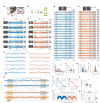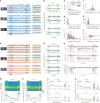Voltage imaging reveals hippocampal inhibitory dynamics shaping pyramidal memory-encoding sequences
- PMID: 40696029
- PMCID: PMC12411278
- DOI: 10.1038/s41593-025-02016-y
Voltage imaging reveals hippocampal inhibitory dynamics shaping pyramidal memory-encoding sequences
Abstract
Hippocampal spiking sequences encode and link behaviorally relevant information across time. How inhibition sculpts these sequences remains unclear. We performed longitudinal voltage imaging of CA1 parvalbumin- and somatostatin-expressing interneurons in mice performing an odor-cued working memory task. Unlike pyramidal odor-specific sequences that encode odor and time throughout a delay period, interneurons encoded odor delivery, but not odor identity or delay time. Odor-triggered inhibition was exerted by stable numbers of interneurons across days, with constant cell turnover, independent of task training. At odor onset, brief spiking of parvalbumin interneurons was followed by widespread hyperpolarization and synchronized theta-paced rebound spiking across interneurons. Electrophysiology, optogenetics and calcium imaging corroborated that parvalbumin interneurons silenced most pyramidal cells during odor delivery, whereas somatostatin interneurons suppressed other interneurons. The few odor-selective pyramidal cells spiked together with interneuronal post-hyperpolarization rebound. Collectively, inhibition increases the signal-to-noise ratio of pyramidal cue representations, enabling efficient encoding of memory-relevant information.
© 2025. This is a U.S. Government work and not under copyright protection in the US; foreign copyright protection may apply.
Conflict of interest statement
Competing interests: The authors declare no competing interests.
Figures













Update of
-
Voltage imaging reveals that hippocampal interneurons tune memory-encoding pyramidal sequences.bioRxiv [Preprint]. 2023 Apr 25:2023.04.25.538286. doi: 10.1101/2023.04.25.538286. bioRxiv. 2023. Update in: Nat Neurosci. 2025 Sep;28(9):1946-1958. doi: 10.1038/s41593-025-02016-y. PMID: 37163029 Free PMC article. Updated. Preprint.
References
MeSH terms
Substances
Grants and funding
LinkOut - more resources
Full Text Sources
Miscellaneous

